Welcome to my next CDS article, and we will be taking an indepth look into the brand new Red-Eyes Support! Red-Eyes B. Dragon has had multiple waves of support over its history, but its most recent wave of support in Clash of Rebellions and Dragons of Legend 2 has left a lot of duelists staggering, unsure of how to build the deck with the wide range and variety of support. It’s time for you to leave that crowd and learn about the newfound power of RED!

History:
Let’s go back to the beginnings of Yu-Gi-Oh… back to when Red-Eyes B. Dragon was first released. Yes, it was the ‘participant’ prize for those that simply couldn’t pull Blue-Eyes White Dragon from their pack of Legend of Blue-Eyes White Dragon. Even in the first movie, it was said that while “Blue-Eyes” brings power, “Red-Eyes” brings potential. Blue-Eyes even got a structure deck all to itself, chock-full of support while Red-Eyes was left with the sad consolation prize of being tournament-worthy for certain rogue duelists for a build known simply as ‘Disaster Dragon’. Yes, Red-Eyes technically got a Structure Deck… but it wasn’t much in the realm of dedicated support. Things simply got worse as Blue-Eyes got White Stone of Legend, giving them the ability to even be used in Exodia variants. Then in recent times, Blue-Eyes made a resurgence as the engine behind the Rank 8 Dragon Ruler variant… leaving the poor Red-Eyes archetype in the dust with only 1 Limited card as its representation. Moral of the story is simple, Blue-Eyes has had its time to shine, now it is time for the Silver Dragons to move over and let the Black Dragons take over. After support in two recent products, Red-Eyes can finally compete, so let’s begin the Red-Eyes Revolution! Besides, it’s about time that a brand new Dragon deck steps up to fill the void left by the banned Dragon Rulers. After all, Dragons were designed as the Ace Monster type!
Wide Array of Choices:

Before I begin, I would like you to look up all of the cards that include “Red-Eyes” in their card text, because there is a ton of options at your disposal and it is important that you are well informed. I could spend thousands of words just introducing the monsters alone, but I would rather spend this article talking about deck theory, how to build Red-Eyes, and how to win with them. So by this point, I am assuming that you are well informed.
The Red-Eyes archetype now has a wide array of boss monsters, each of them include a different purpose in relation to main strategic playstyles. An example of this is Archfiend Black Skull Dragon, a card completely dedicated to being Aggressive. On the other hand, Lord of the Red contributes to the Disruption capabilities of the archetype. All of the main power cards of the new Red-Eyes deck therefore contribute to a different overall strategy of the deck. This creates a big conundrum for duelists trying to figure out how to build a Red-Eyes deck, because they see the Ritual components and the Fusion components of the archetype and expect a deck using both of them to work excellently since it is the same archetype. But that is precisely the issue with the situation, since both the Fusion elements and the Ritual elements cater to different strategies. The same could be said of the Spell and Trap support and much of the monster support as well. As a result of these inconsistencies, you have to be smart at the deckbuilding phase in order for a Red-Eyes variant to work.
Again, I would like to stress one point – the deck is not completely dysfunctional however you build it. You can definitely build a hodgepodge Red-Eyes deck that includes all different forms of its support, and there is a shot that it could work out, but most builds of this nature do not have enough synergy to remain consistent through a long event. Therefore, in order to win with Red-Eyes, you have to begin by choosing a specific strategy and win condition upon which to focus. So keep that in mind as we continue through this article, as I am definitely going to be throwing builds at you left and right. Let’s begin with the first Red-Eyes variant of the article, one designed to emphasize consistency.

Consistent Red-Eyes:
Example Decklist: Click Here.
Right away, you will notice that this version of Red-Eyes drops the 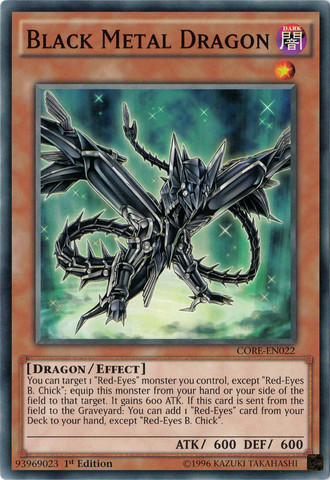 Archfiend component completely, and I am starting with this variant to explain that you do NOT need to run Archfiend Black Skull Dragon when using Red-Eyes. Archfiend is a very powerful card, as it should be as the new ‘boss’ monster of the archetype. But to be frank, it requires you to be playing extremely recklessly. In order to actually have a shot of Summoning it, you need to be running at least 2 Red-Eyes Fusion, which then forces you to run 2 Summoned Skull and 2 Red-Eyes B. Dragon as well. That is 4 Normal Monsters that pretty much cannot do anything on their own, and pretty much only serve as discard fodder when you draw into them. In other words, you are just asking for dead draws. Therefore, if you want to have a consistent Red-Eyes deck, you must eliminate the potential for these dead draws. Now hold up a second, I am not being hypocritical by keeping the normal Red-Eyes in this ‘consistent’ version, simply because there is a lot more utility for him in this sort of build. Red-Eyes Darkness Dragon was the original ‘new boss monster’ of the theme whenever it was first released headlining the Dragon Structure deck, and it can still have an amazing impact in Red-Eyes decks today. It is searchable by Black Metal Dragon (BMD) and more importantly, it can hit extreme levels of ATK power. Speaking of BMD, let’s talk about how this little dragon gives the deck as much consistency as it can.
Archfiend component completely, and I am starting with this variant to explain that you do NOT need to run Archfiend Black Skull Dragon when using Red-Eyes. Archfiend is a very powerful card, as it should be as the new ‘boss’ monster of the archetype. But to be frank, it requires you to be playing extremely recklessly. In order to actually have a shot of Summoning it, you need to be running at least 2 Red-Eyes Fusion, which then forces you to run 2 Summoned Skull and 2 Red-Eyes B. Dragon as well. That is 4 Normal Monsters that pretty much cannot do anything on their own, and pretty much only serve as discard fodder when you draw into them. In other words, you are just asking for dead draws. Therefore, if you want to have a consistent Red-Eyes deck, you must eliminate the potential for these dead draws. Now hold up a second, I am not being hypocritical by keeping the normal Red-Eyes in this ‘consistent’ version, simply because there is a lot more utility for him in this sort of build. Red-Eyes Darkness Dragon was the original ‘new boss monster’ of the theme whenever it was first released headlining the Dragon Structure deck, and it can still have an amazing impact in Red-Eyes decks today. It is searchable by Black Metal Dragon (BMD) and more importantly, it can hit extreme levels of ATK power. Speaking of BMD, let’s talk about how this little dragon gives the deck as much consistency as it can.
First, BMD is a Level 1 monster, which means that he has a slew of support cards that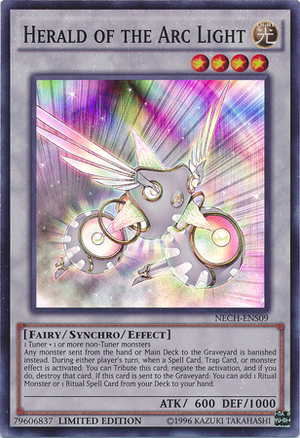 can allow him to re-use his effect time and time again. More importantly, he can be Special Summoned back from the Graveyard by Junk Synchron. You will definitely see this combination in some of my other variants in this article, so be sure to pay attention. Junk is used as a way to turn one Normal Summon into a +3 if handled correctly, and that is all through the power of Herald of the Arc Light. While this Synchro monster is more notably found in Nekroz due to Kaleidioscope, Herald has also found use in many Ritual decks, especially those that splash in a small Deskbot engine in order to access it. Not only does Herald offer a negation of any spell/trap or monster effect, but it also prevents your opponent from milling or discarding from the hand or deck to the Graveyard. This is extremely disruptive against Shaddolls and Burning Abyss, but it can also impact many other matchups as well. The real prize is what happens when Herald hits the Graveyard, because you get a free Ritual Spell or Ritual Monster from the deck to your hand. As you surely notice, this variant of Red-Eyes commonly uses Paladin of Dark Dragon, due to its ability to Special Summon Red-Eyes Darkness Metal Dragon [REDMD] directly from the Deck. After doing so, you can simply Special Summon Paladin right back, giving you an immediate +1 in card advantage. In addition, Dark Dragon Ritual, the Ritual Spell used for Paladin, can banish itself from the Graveyard in order to add any “Red-Eyes” Spell/Trap Card from the Deck to the hand. So if you performed the Ritual Summon successfully, by the next turn, your investment would be paid off and then some.
can allow him to re-use his effect time and time again. More importantly, he can be Special Summoned back from the Graveyard by Junk Synchron. You will definitely see this combination in some of my other variants in this article, so be sure to pay attention. Junk is used as a way to turn one Normal Summon into a +3 if handled correctly, and that is all through the power of Herald of the Arc Light. While this Synchro monster is more notably found in Nekroz due to Kaleidioscope, Herald has also found use in many Ritual decks, especially those that splash in a small Deskbot engine in order to access it. Not only does Herald offer a negation of any spell/trap or monster effect, but it also prevents your opponent from milling or discarding from the hand or deck to the Graveyard. This is extremely disruptive against Shaddolls and Burning Abyss, but it can also impact many other matchups as well. The real prize is what happens when Herald hits the Graveyard, because you get a free Ritual Spell or Ritual Monster from the deck to your hand. As you surely notice, this variant of Red-Eyes commonly uses Paladin of Dark Dragon, due to its ability to Special Summon Red-Eyes Darkness Metal Dragon [REDMD] directly from the Deck. After doing so, you can simply Special Summon Paladin right back, giving you an immediate +1 in card advantage. In addition, Dark Dragon Ritual, the Ritual Spell used for Paladin, can banish itself from the Graveyard in order to add any “Red-Eyes” Spell/Trap Card from the Deck to the hand. So if you performed the Ritual Summon successfully, by the next turn, your investment would be paid off and then some.
Returning back to our Herald conversation, the whole reason why BMD is important is because it prepares any number of plays and strategies and sets up the correct number and arrangement of Red-Eyes cards in order to adapt to a given situation. A search card is only as good as what it can search, but in the case of BMD, you can search out: REDMD itself to add power to the field, Red-Eyes Darkness Dragon the game ender, Red-Eyes Spirit your themed recovery, Red-Eyes Return the continuous trap that keeps fueling endless streams of monsters, or even Red-Eyes Tracer Dragon to prepare for your field getting wiped out. A consistent deck is one that can get to its main engine whenever it is needed, and this ‘consistent’ Red-Eyes deck either gives you the tools to win the duel at the beginning or a means of getting to those tools, albeit sometimes in a roundabout way.
Before I continue, I would like to talk about one other extremely powerful card that I 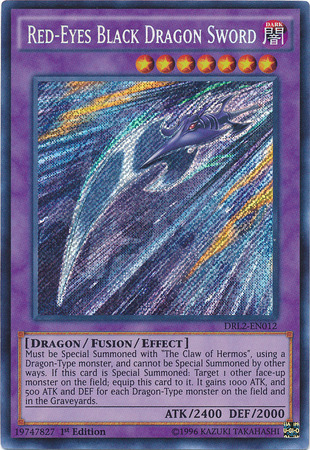 have neglected to mention thus far – The Claw of Hermos. This Spell Card from Dragons of Legend 2 allows you to bring out the second new Red-Eyes Fusion monster – Red-Eyes Black Dragon Sword. Sword equips itself to another monster on the field, giving it a powerful boost in ATK and DEF based on the number of Dragons on the field and in the Graveyard. Again, you can create extremely powerful monsters with this card, creating a pseudo Red-Eyes Darkness Dragon whenever you need the brute force to muscle through an opponent. This is your answer to Apoqliphort Towers, and this is the way many OTKs will begin.
have neglected to mention thus far – The Claw of Hermos. This Spell Card from Dragons of Legend 2 allows you to bring out the second new Red-Eyes Fusion monster – Red-Eyes Black Dragon Sword. Sword equips itself to another monster on the field, giving it a powerful boost in ATK and DEF based on the number of Dragons on the field and in the Graveyard. Again, you can create extremely powerful monsters with this card, creating a pseudo Red-Eyes Darkness Dragon whenever you need the brute force to muscle through an opponent. This is your answer to Apoqliphort Towers, and this is the way many OTKs will begin.
Perhaps this version of Red-Eyes doesn’t float your boat, that’s fine. There are plenty more boss monsters and various strategies within the Red-Eyes umbrella to discuss, and this next variant is going to cut down on the element of consistency in order to exaggerate the Aggressive qualities of the deck.
Red-Eyes Burn:
Example Decklist: Click Here.
While the first build was centered around preserving consistency and opening up as 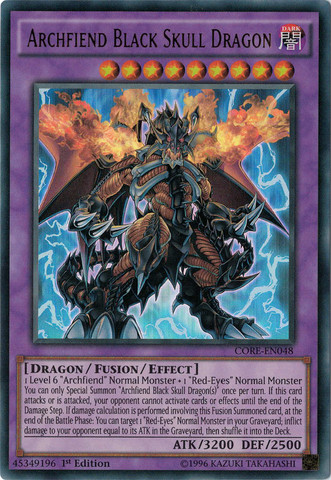 many plays as possible, you will immediately notice that this Red-Eyes build throws that set of values out of the window in order to maximize on the pure level of damage available to the archetype. Guided by the flagship boss monster, Archfiend Black Skull Dragon, the whole entire purpose is to get to him fast then win the duel quick. In an extended duel, you will not have many options come lategame in order to swing back into the duel. If you are immediately shaming this build for being inconsistent, I am proud to have finally rubbed off on you after so many of these articles flaunting the importance of consistency in order to make decks function at a high level. But this example decklist is not being showcased as only an exaggeration, it is actually a perfect example of the flipside to consistency in terms of deck theory – this build is designed around making sure that you get to your win condition card as soon as possible. In this case, that is the Fusion boss monster, so the entire deck is build around getting to Red-Eyes Fusion. While this Spell card does not seem to be carrying anything special, you should not take the ability of milling monsters from the deck lightly, because it is the alpha and the omega for this sort of Red-Eyes deck. So let’s analyze the build from a theory-based perspective.
many plays as possible, you will immediately notice that this Red-Eyes build throws that set of values out of the window in order to maximize on the pure level of damage available to the archetype. Guided by the flagship boss monster, Archfiend Black Skull Dragon, the whole entire purpose is to get to him fast then win the duel quick. In an extended duel, you will not have many options come lategame in order to swing back into the duel. If you are immediately shaming this build for being inconsistent, I am proud to have finally rubbed off on you after so many of these articles flaunting the importance of consistency in order to make decks function at a high level. But this example decklist is not being showcased as only an exaggeration, it is actually a perfect example of the flipside to consistency in terms of deck theory – this build is designed around making sure that you get to your win condition card as soon as possible. In this case, that is the Fusion boss monster, so the entire deck is build around getting to Red-Eyes Fusion. While this Spell card does not seem to be carrying anything special, you should not take the ability of milling monsters from the deck lightly, because it is the alpha and the omega for this sort of Red-Eyes deck. So let’s analyze the build from a theory-based perspective.
First, there is 3 copies of Red-Eyes Fusion which gives the duelist the absolute best odds of drawing into the Spell in the early game. In addition, 3 copies of BMD are ran in order to search Fusion straight out of the deck. This is a total of 6 different cards that are either your win condition or only a card away from your win condition. This is an excellent baseline for beginning to construct the deck, but there is also the issue of Fusion components that you need to address. This is where the most important theory begins to push on your decision-making, because you should be asking the question: “If I am running 3 Red-Eyes Fusion, how many Normal monsters can I afford to run?” If you choose to run only 1 of Red-Eyes B. Dragon and Summoned Skull, you run into a big problem for the deck – what happens if you need to Fusion summon twice in a single duel. Quite frankly, you would need to rely on your Return of the Red-Eyes or Daigusto Emeral just in order to prepare another Fusion activation. There is another problematic scenario as well, what happens if you draw into your Normal monsters instead of fusing them from the deck? For each Normal Monster you draw, Fusion will cause a drop in card economy, something that you cannot afford when using a deck focused around burn damage as a win condition.
So now that we have eliminated 1 of each Normal as a viable option, let’s consider the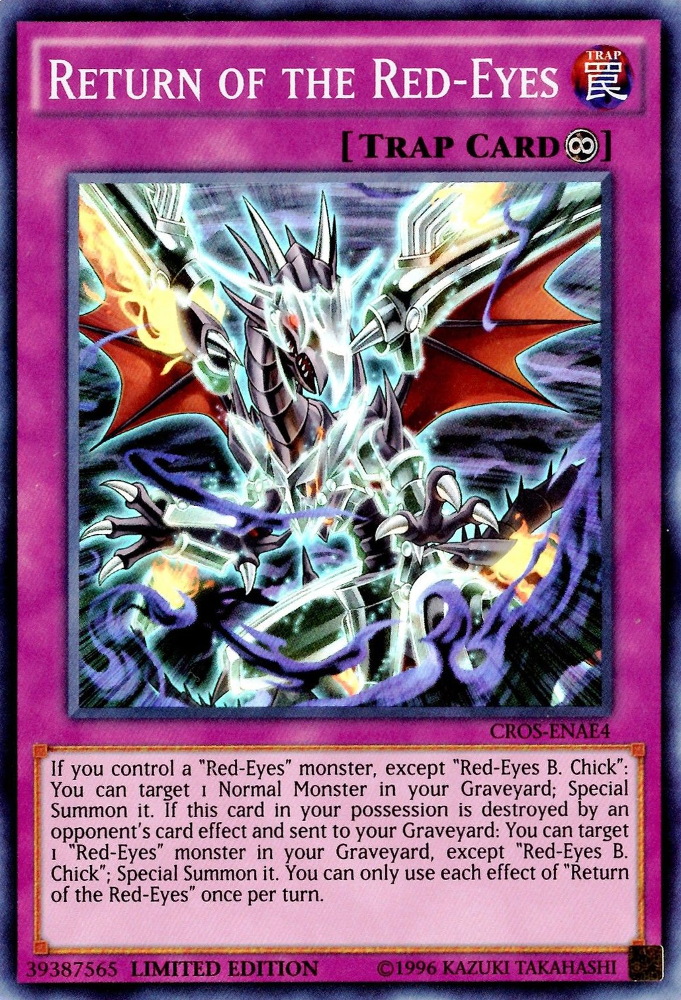 other extreme – 3 of each. Again, this causes a total of 6 cards so off of the bat, you have the same odds of drawing one of your Normal Monsters as drawing either BMD or Red-Eyes Fusion. While that seems like an extremely unpleasant fact, it is offset by the fact that the two problems with the ‘one of each’ scenario are solved. If you happen to draw 2 Normal Monsters, your Red-Eyes Fusion will remain a even trade in card advantage, even if your opponent has a response to the summon. In addition, you have even more potential of abusing the effect of Return of the Red-Eyes to seal a duel, due to having so many Normal Monsters to keep bringing back. Lastly, you are running a deck that can easily afford discarding Normal monsters to the Graveyard for Dragon Ravine in order to setup the Dragons that need the Graveyard, so the brick hands are somewhat less ‘useless’ since the Normals want to be in the Graveyard anyways if you draw them. Just so you’re aware, I clearly designed this example variant with this perspective in order to explain a good through process when approaching how to build a new deck, and besides, my CDS articles are about more than just the archetypes described in the title, but I think it’s time to get back to our pet dragons. One last side point – Later in this article, you will see a build running 2 of each Normal Monster, and to avoid being wordy, the reasoning behind that is that the reasoning for such a choice logically falls directly between the arguments I just fleshed out.
other extreme – 3 of each. Again, this causes a total of 6 cards so off of the bat, you have the same odds of drawing one of your Normal Monsters as drawing either BMD or Red-Eyes Fusion. While that seems like an extremely unpleasant fact, it is offset by the fact that the two problems with the ‘one of each’ scenario are solved. If you happen to draw 2 Normal Monsters, your Red-Eyes Fusion will remain a even trade in card advantage, even if your opponent has a response to the summon. In addition, you have even more potential of abusing the effect of Return of the Red-Eyes to seal a duel, due to having so many Normal Monsters to keep bringing back. Lastly, you are running a deck that can easily afford discarding Normal monsters to the Graveyard for Dragon Ravine in order to setup the Dragons that need the Graveyard, so the brick hands are somewhat less ‘useless’ since the Normals want to be in the Graveyard anyways if you draw them. Just so you’re aware, I clearly designed this example variant with this perspective in order to explain a good through process when approaching how to build a new deck, and besides, my CDS articles are about more than just the archetypes described in the title, but I think it’s time to get back to our pet dragons. One last side point – Later in this article, you will see a build running 2 of each Normal Monster, and to avoid being wordy, the reasoning behind that is that the reasoning for such a choice logically falls directly between the arguments I just fleshed out.
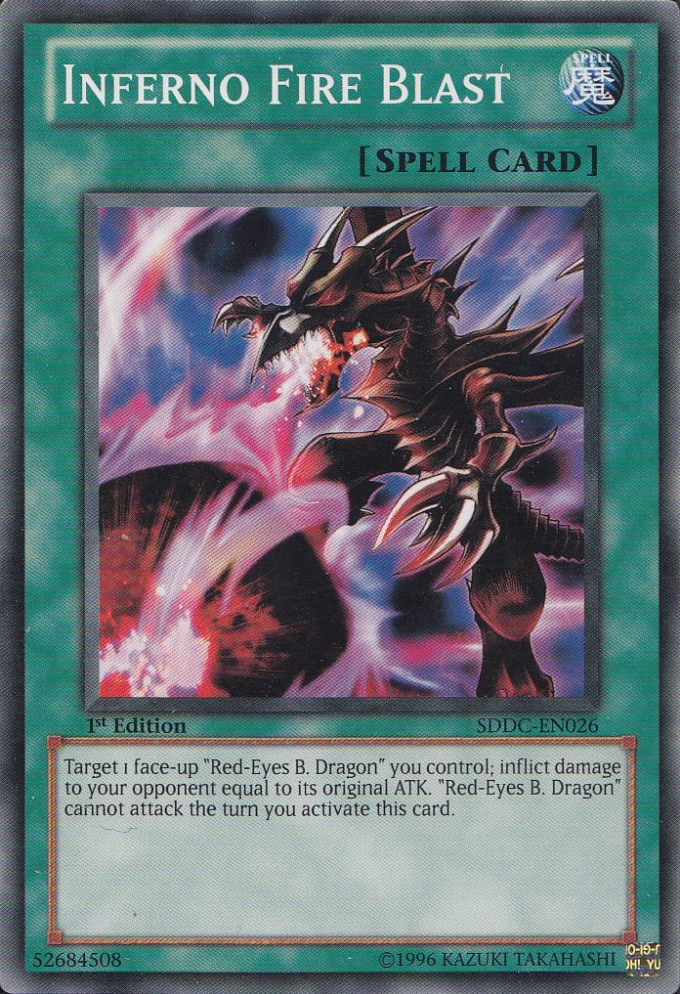 There is one one Red-Eyes support card that truly focuses entirely on heavy Burn Damage – Inferno Fire Blast. While the Spell card can easily inflict either 2400 to 3200 damage, you can’t quite justify its presence in other variants because it is easily seen as a ‘win more’ card. If you can activate it, you already have a Red-Eyes B. Dragon or a Fusion monster on the field, so you should already be in a strong position during the duel. If you are behind, an Inferno Fire Blast cannot offset a difference in card advantage, since it requires you to already have a powerful monster as field presence. At the end of the day, it works in this variant simply because a deck that is already designed to be risky and blind-fully aggressive can only benefit from win-more cards. This argument is simple because if you are ahead, you better win the duel quickly, and if you are behind, you would have lost the duel anyways. At the end of the day, that is the logic you should be considering when deciding which Red-Eyes variant you want to build. If you are a more risky and aggressive player, by all means look into abusing the Burn options available to you. But if you prefer a more consistent strategy, you may wish to take a bit of a safer approach to the archetype. But that’s enough about the duality of risk and reward with the early game of a duel, it’s time to take a gander at a Red-Eyes deck that focuses on Xyz monsters as bosses and executing combo potential at the right time of the duel!
There is one one Red-Eyes support card that truly focuses entirely on heavy Burn Damage – Inferno Fire Blast. While the Spell card can easily inflict either 2400 to 3200 damage, you can’t quite justify its presence in other variants because it is easily seen as a ‘win more’ card. If you can activate it, you already have a Red-Eyes B. Dragon or a Fusion monster on the field, so you should already be in a strong position during the duel. If you are behind, an Inferno Fire Blast cannot offset a difference in card advantage, since it requires you to already have a powerful monster as field presence. At the end of the day, it works in this variant simply because a deck that is already designed to be risky and blind-fully aggressive can only benefit from win-more cards. This argument is simple because if you are ahead, you better win the duel quickly, and if you are behind, you would have lost the duel anyways. At the end of the day, that is the logic you should be considering when deciding which Red-Eyes variant you want to build. If you are a more risky and aggressive player, by all means look into abusing the Burn options available to you. But if you prefer a more consistent strategy, you may wish to take a bit of a safer approach to the archetype. But that’s enough about the duality of risk and reward with the early game of a duel, it’s time to take a gander at a Red-Eyes deck that focuses on Xyz monsters as bosses and executing combo potential at the right time of the duel!
Gemini Red-Eyes:
Example Decklist: Click Here.
This is CDS after all, so I have to throw some off-the-wall ideas at you, my dear  reader. Introducing the variant that I expected to be a fluke from the beginning, then was quickly proven wrong when it actually exceeded expectations by a long shot. While Supervise had appeared in previous example variants as a tech option in order to give access to Flare’s burn damage or Archfiend’s nuke, this is the specific variant in which the equip spell shines. Similarly to the Gigavise deck that has remained a rogue outlier waiting for its chance to shine, sometimes all it takes is a strong Gemini monster to build a variant. The best thing is, Red-Eyes has their own version of Lonefire Blossom in The Black Stone of Legend and they even have Graveyard recursion as well due to the effect of Return of the Red-Eyes. Unlike the Gigavise deck, this form of Red-Eyes can rely on the inherent power of Gemini monsters and their support, since the Red-Eyes deck can be a bit more versatile than straight Synchro Spam. The first of this Gemini support is clearly the best Gemini monster to pair Supervise with, Blazewing Butterfly.
reader. Introducing the variant that I expected to be a fluke from the beginning, then was quickly proven wrong when it actually exceeded expectations by a long shot. While Supervise had appeared in previous example variants as a tech option in order to give access to Flare’s burn damage or Archfiend’s nuke, this is the specific variant in which the equip spell shines. Similarly to the Gigavise deck that has remained a rogue outlier waiting for its chance to shine, sometimes all it takes is a strong Gemini monster to build a variant. The best thing is, Red-Eyes has their own version of Lonefire Blossom in The Black Stone of Legend and they even have Graveyard recursion as well due to the effect of Return of the Red-Eyes. Unlike the Gigavise deck, this form of Red-Eyes can rely on the inherent power of Gemini monsters and their support, since the Red-Eyes deck can be a bit more versatile than straight Synchro Spam. The first of this Gemini support is clearly the best Gemini monster to pair Supervise with, Blazewing Butterfly.
Blazewing’s Gemini effect is straightforward – Trade itself for a different Gemini  monster in your Graveyard and instantly give that summoned monster its effect. Combine that with Supervise, and you get to trade the Equip Spell and Blazewing for 2 Gemini monsters of your choice, perhaps Red-Eyes Black Flare Dragon and Red-Eyes Black Flare Dragon, both of which can be conveniently dumped to the Graveyard by a single Dragon Shrine. Then, you can overlay those two monsters to go into the main boss of this variant, Red-Eyes Flare Metal Dragon. With your Xyz monster on the field, you can easily begin to outscale the opponent in card advantage and in life point advantage, especially when multiple monster effects are needed in order to remove it from the field.
monster in your Graveyard and instantly give that summoned monster its effect. Combine that with Supervise, and you get to trade the Equip Spell and Blazewing for 2 Gemini monsters of your choice, perhaps Red-Eyes Black Flare Dragon and Red-Eyes Black Flare Dragon, both of which can be conveniently dumped to the Graveyard by a single Dragon Shrine. Then, you can overlay those two monsters to go into the main boss of this variant, Red-Eyes Flare Metal Dragon. With your Xyz monster on the field, you can easily begin to outscale the opponent in card advantage and in life point advantage, especially when multiple monster effects are needed in order to remove it from the field.
The other main advantage that this build brings is that you can completely drop the pure Normal Monsters from your build. That’s right, no plain old Red-Eyes B. Dragon is needed! Monster Effects dictate the game, and the lack of such effects is a serious check to the power of a deck if you are forced to run Normal Monsters. But since Gemini monsters are treated as Normal Monsters in the Graveyard, you can reap the benefits of the Red-Eyes Normal Monster support while including as many Monster Effects as possible! The neat thing is that you do not even have to drop access to Archfiend Black Skull Dragon. That’s right, we can still summon him without even having Summoned Skull and that access is through Dragon’s Mirror!
Since Red-Eyes Archfiend of Lightning is a Normal Monster in the Graveyard, he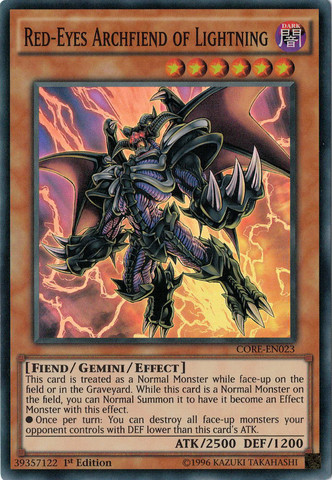 fulfills the requirement of the Level 6 Archfiend Fusion material for Black Skull! Even though Archfiend’s effect is useful enough with Supervise, it plays a pivotal role in creating favorable endgame scenarios. If your opponent tries to go for a strong field, you can just wipe them out with just his effect. In addition, running 2 of this Gemini monster allows you to rely upon Rank 6 Xyz monsters as well in a pinch. At the end of the day, this Gemini variant can also be considered the Xyz-focused Red-Eyes variant, simply because it has reliable access to Rank 6 and 7 Xyz Monsters all off of a single 2-card combo. In addition, you can always use a Keeper of the Shrine to Xyz Summon a Rank 4 monster with a Blazewing Butterfly in a pinch. After all, Blazewing can be Special Summoned by Return of the Red-Eyes or by Swing of Memories… But enough about Gemini monsters, let’s talk about the other main combo Red-Eyes Variant!
fulfills the requirement of the Level 6 Archfiend Fusion material for Black Skull! Even though Archfiend’s effect is useful enough with Supervise, it plays a pivotal role in creating favorable endgame scenarios. If your opponent tries to go for a strong field, you can just wipe them out with just his effect. In addition, running 2 of this Gemini monster allows you to rely upon Rank 6 Xyz monsters as well in a pinch. At the end of the day, this Gemini variant can also be considered the Xyz-focused Red-Eyes variant, simply because it has reliable access to Rank 6 and 7 Xyz Monsters all off of a single 2-card combo. In addition, you can always use a Keeper of the Shrine to Xyz Summon a Rank 4 monster with a Blazewing Butterfly in a pinch. After all, Blazewing can be Special Summoned by Return of the Red-Eyes or by Swing of Memories… But enough about Gemini monsters, let’s talk about the other main combo Red-Eyes Variant!
Red-Eyes Hieratic:
Example Decklist: Click Here.
I’m sure you’ve run into this Red-Eyes variant in the past, perhaps even before the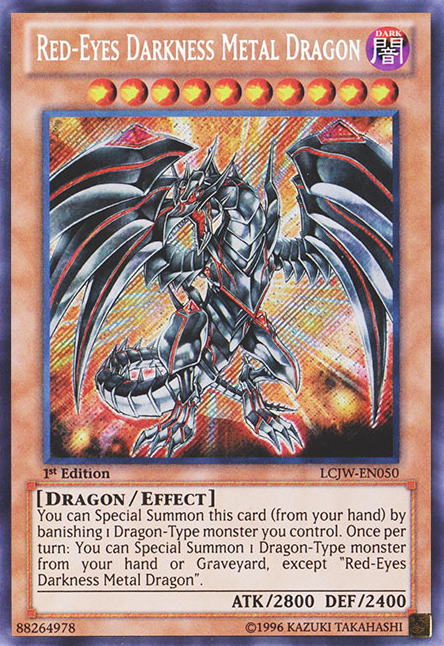 latest wave of support. Back in the day, the Hieratic engine was seen as the best way to get to Red-Eyes B. Dragon, since you could Special Summon him whenever a Hieratic monster was tributed. The focus of this hybrid was to facilitate the summon of a powerful Red-Eyes Darkness Dragon, since the Hieratic archetype tends to flood the Graveyard extremely quickly with a bunch of Dragon-type monsters. While this neat deck never caught on in competitive play, it has only gotten stronger with the wave of new support, and I have decided to go with a fully teched out example build in order to showcase all of the amazing combo potential available to such a variant. Please note, many builds of Red-Eyes Hieratic would work more consistently at a single strength if you chose to drop an engine or two in the above example, but I chose to go for versatility which is why the deck is spread thin with 8 different archetypes represented in the Main Deck.
latest wave of support. Back in the day, the Hieratic engine was seen as the best way to get to Red-Eyes B. Dragon, since you could Special Summon him whenever a Hieratic monster was tributed. The focus of this hybrid was to facilitate the summon of a powerful Red-Eyes Darkness Dragon, since the Hieratic archetype tends to flood the Graveyard extremely quickly with a bunch of Dragon-type monsters. While this neat deck never caught on in competitive play, it has only gotten stronger with the wave of new support, and I have decided to go with a fully teched out example build in order to showcase all of the amazing combo potential available to such a variant. Please note, many builds of Red-Eyes Hieratic would work more consistently at a single strength if you chose to drop an engine or two in the above example, but I chose to go for versatility which is why the deck is spread thin with 8 different archetypes represented in the Main Deck.
So firstly, this is the second Red-Eyes deck that can actually summon out Red-Eyes  Flare Metal Dragon consistently, and the engine that allows that is by including D/D/D Dragon King Pendragon. Please don’t look at me like I am crazy, there is actually some important ties to synergy with this core tech card. Not only can you actually use the Summoned Skull if you ever draw it, but you can also trigger the effects of other tech Fiend-type cards in order to clear the way for your plays, such as Farfa, Malebranche of the Burning Abyss that I chose to use in the example build. While Pendragon’s summoning is a -2 overall, you can definitely offset the loss in card advantage by Tributing a Hieratic monster or even by searching out Pendragon in the first place with the effect of Dwarf Star Dragon Planetar. Either way, Pendragon is a perfect example of losing card advantage to then make it up with your Xyz Monster, since Flare Metal Dragon does have the uncanny ability to summon back 2 Red-Eyes monsters over 2 turns. Quite frankly, Pendragon gives you a method of making one-for-one trades with non-targeting backrow removal WHILE setting up your combos in order to Xyz Summon. It can be considered a win-win scenario in an aggressive combo deck that wants to eliminate the opponent’s options before going in for a kill.
Flare Metal Dragon consistently, and the engine that allows that is by including D/D/D Dragon King Pendragon. Please don’t look at me like I am crazy, there is actually some important ties to synergy with this core tech card. Not only can you actually use the Summoned Skull if you ever draw it, but you can also trigger the effects of other tech Fiend-type cards in order to clear the way for your plays, such as Farfa, Malebranche of the Burning Abyss that I chose to use in the example build. While Pendragon’s summoning is a -2 overall, you can definitely offset the loss in card advantage by Tributing a Hieratic monster or even by searching out Pendragon in the first place with the effect of Dwarf Star Dragon Planetar. Either way, Pendragon is a perfect example of losing card advantage to then make it up with your Xyz Monster, since Flare Metal Dragon does have the uncanny ability to summon back 2 Red-Eyes monsters over 2 turns. Quite frankly, Pendragon gives you a method of making one-for-one trades with non-targeting backrow removal WHILE setting up your combos in order to Xyz Summon. It can be considered a win-win scenario in an aggressive combo deck that wants to eliminate the opponent’s options before going in for a kill.
Next up on my list of discussion points for this specific deck is the unique 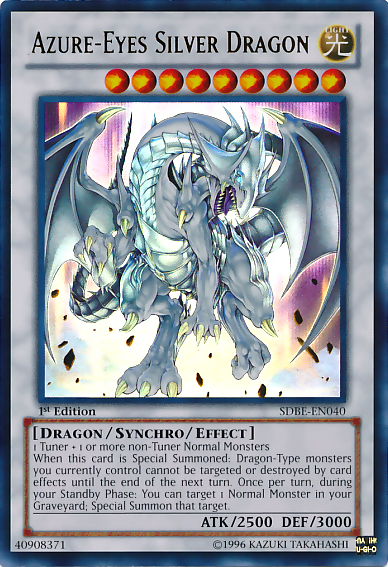 composition of the Extra Deck. Due to the fact that there are multiple Normal Monster Dragon-type Tuners, all of different levels, this is the first variant that can actually rely upon Synchro monsters as actual boss monsters to rely on. Since this is Hieratics after all, it is the perfect opportunity to throw Ultimaya Tzolkin into the mix! This gives you access to a stready stream of powerful Dragon-type Synchro Monsters, such as the destruction-oriented Scrap Dragon or the defensive-oriented Clear Wing Synchro Dragon! Above all of these Synchro monsters is one specific Dragon-type monster that can truly help justify this deck by acting as a pseudo REDMD – Azure-Eyes Silver Dragon. Yes, that’s correct – Red-Eyes can totally steal the Blue-Eyes extra deck monster when they get a Level 2 tuner that meshes beautifully with the deck! On top of the constant recursion offered by Return of the Red-Eyes, Red-Eyes Flare Metal Dragon, and REDMD… This is amazing. This recursion actually gives the Hieratic Red-Eyes deck a snowball effect of compiling monster advantage of constant boss monsters from the Graveyard.
composition of the Extra Deck. Due to the fact that there are multiple Normal Monster Dragon-type Tuners, all of different levels, this is the first variant that can actually rely upon Synchro monsters as actual boss monsters to rely on. Since this is Hieratics after all, it is the perfect opportunity to throw Ultimaya Tzolkin into the mix! This gives you access to a stready stream of powerful Dragon-type Synchro Monsters, such as the destruction-oriented Scrap Dragon or the defensive-oriented Clear Wing Synchro Dragon! Above all of these Synchro monsters is one specific Dragon-type monster that can truly help justify this deck by acting as a pseudo REDMD – Azure-Eyes Silver Dragon. Yes, that’s correct – Red-Eyes can totally steal the Blue-Eyes extra deck monster when they get a Level 2 tuner that meshes beautifully with the deck! On top of the constant recursion offered by Return of the Red-Eyes, Red-Eyes Flare Metal Dragon, and REDMD… This is amazing. This recursion actually gives the Hieratic Red-Eyes deck a snowball effect of compiling monster advantage of constant boss monsters from the Graveyard.
Despite all of the advantages to this sort of Red-Eyes deck that I have already mentioned, I think the absolute best reason to use Hieratics in your Red-Eyes variant is the backrow control. With the help of A Wingbeat of Giant Dragon combined with the uncanny quality of the Hieratic archetype to get high leveled Dragons to the field with minimal effort, you should face little resistance from an opponent’s backrow. To add to Wingbeat is obviously Pendragon, Hieratic Dragon of Su, and even the typical backrow destruction options such as Mystical Space Typhoon or Galaxy Cylone, so you should be in a position of confidence often enough to actually push forward with your plays. Just avoid wiping out your own Return of the Red-Eyes if you can avoid it! Now that I’ve introduced a build that promotes Fusion, Synchro, or Xyz Summoning its boss monsters, let’s check out a build dedicated to the last boss monsters for Red-Eyes, the Rituals!
Red-Eyes Black Luster:
Example Decklist: Click Here.
It’s actually quite impressive how the names of the two archetypes can actually fit 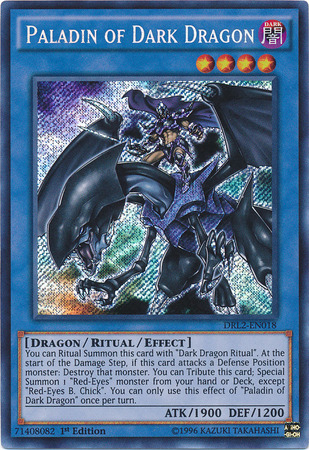 together so well for a good title! Semantics aside, this deck is actually quite powerful in the right hands due to the individual power of each of the Ritual Monsters! So let’s meet our two main Ritual contenders – in the Level 4 corner, Paladin of Dark Dragon fills a similar role as in the Consistency variant – Ritual summon him as an instant summon of REDMD from the deck, then you get Paladin right back from the Graveyard. After the Ritual Summon, you can banish the Ritual Spell from the Graveyard in order to add a ‘Red-Eyes’ Spell or Trap card from the deck to the hand. Therefore, Paladin is the beginning and the end of your plays, acting as your first Ritual Summon which then setups up your second ritual summon while still giving you a solid field presence to boot. What is the second Ritual Summon you may ask? Well, this Level 8 boss monster is a Dragon to be reckoned with. And fun fact, he is the second FIRE Ritual Monster in existence… (There still are 0 WIND Ritual Monsters by the way, just want to point that out… again.)
together so well for a good title! Semantics aside, this deck is actually quite powerful in the right hands due to the individual power of each of the Ritual Monsters! So let’s meet our two main Ritual contenders – in the Level 4 corner, Paladin of Dark Dragon fills a similar role as in the Consistency variant – Ritual summon him as an instant summon of REDMD from the deck, then you get Paladin right back from the Graveyard. After the Ritual Summon, you can banish the Ritual Spell from the Graveyard in order to add a ‘Red-Eyes’ Spell or Trap card from the deck to the hand. Therefore, Paladin is the beginning and the end of your plays, acting as your first Ritual Summon which then setups up your second ritual summon while still giving you a solid field presence to boot. What is the second Ritual Summon you may ask? Well, this Level 8 boss monster is a Dragon to be reckoned with. And fun fact, he is the second FIRE Ritual Monster in existence… (There still are 0 WIND Ritual Monsters by the way, just want to point that out… again.)
Lord of the Red is the second Red-Eyes related boss monster, and quite frankly, 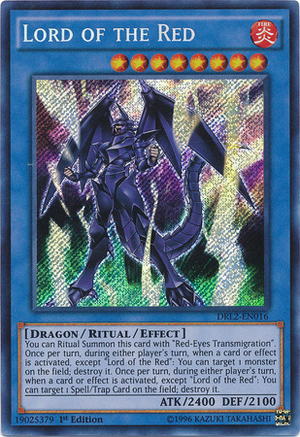 he is the more accessible and more powerful monster available to the deck, simply because his Ritual Spell is actually a ‘Red-Eyes’ card! His effect however, that is where this deck truly begins to hit form. Basically, he has 2 once per turn quick effects, one to destroy a Spell or Trap and the other to destroy a monster, but each can only be activated whenever another card or effect is activated. The best way to use this effect to your advantage is to use the Spell/Trap destruction effect first, then chain on the Monster destruction effect if your opponent decides to chain the original target. Even if Lord gets hit with a Bottomless Trap Hole, Breakthrough Skill, Compulsory Evacuation Device, Mirror Force, or pretty much any other major trap, you still get to trade Lord for at least 1 other card your opponent controls. In a card advantage sense, this is literally the perfect go-to boss monster for a deck that struggles in maintaining card advantage as the duel is extended. Even in a practical sense, this is an amazing monster, despite requiring such a heavy investment as any Ritual Monster does. But that’s precisely where the second half of the deck steps in – It’s finally time to talk about the Black Luster portion of this deck!
he is the more accessible and more powerful monster available to the deck, simply because his Ritual Spell is actually a ‘Red-Eyes’ card! His effect however, that is where this deck truly begins to hit form. Basically, he has 2 once per turn quick effects, one to destroy a Spell or Trap and the other to destroy a monster, but each can only be activated whenever another card or effect is activated. The best way to use this effect to your advantage is to use the Spell/Trap destruction effect first, then chain on the Monster destruction effect if your opponent decides to chain the original target. Even if Lord gets hit with a Bottomless Trap Hole, Breakthrough Skill, Compulsory Evacuation Device, Mirror Force, or pretty much any other major trap, you still get to trade Lord for at least 1 other card your opponent controls. In a card advantage sense, this is literally the perfect go-to boss monster for a deck that struggles in maintaining card advantage as the duel is extended. Even in a practical sense, this is an amazing monster, despite requiring such a heavy investment as any Ritual Monster does. But that’s precisely where the second half of the deck steps in – It’s finally time to talk about the Black Luster portion of this deck!

While many readers were looking forward to a standalone BLS article, this is my compromise to include at least a little segment in this article, so I will do my best to do the theme justice. The new Black Luster Soldier support is all about supporting Level 8 Ritual Summons, so why not incorporate at least part of the BLS engine into a deck focused on Lord of the Red? While the baby BLS ‘Knight’ monsters can technically search out any Ritual Spell or Ritual monster, it is actually more important to run the ‘Gaia The Fierce Knight’ duo instead, since they activate when they are tributed. Also, both of these Gaias can be searched out of the deck by a single Field Spell, Chaos Field, that also happens to be able to search out either of the Red-Eyes Ritual Spells. To add a sweet cheery on top of the already amazing hybrid sundae of a deck we are creating, did you realize that the Gaia monsters immediately activate following the Ritual Summon of Lord of the Red, if you choose to tribute either for the Ritual Summon, so you get to destroy a card of your opponent’s choice right away! And if you can’t perform that play, simply tribute off Galloping Gaia the Fierce Knight to Ritual Summon your Paladin, because you get a REDMD, Paladin, BLS – Envoy, and a Red-Eyes Transmigration during the next turn! That play is a perfect example of swings in card advantage and momentum that allow you to take control of a duel and quickly enter into a winning position.
So now that we’ve gotten the main strategic points of discussion out of the way, let us talk about the elephant in the room – why the lack of Red-Eyes cards? Where is the Black Stone, where is Red-Eyes itself, where is Flare, where is Fusion…? In fact, all of those cards are detrimental to the overarching Ritual theme of this variant. Ritual Monsters and Ritual Spells already cause enough issues for deckbuilders due to the issues of drawing incompatible matches, so eliminating in the possibility of additional dead draws is pretty much a priority. Also, almost all of the relevant Red-Eyes monsters are level 7 or lower, so you cannot rely upon them to Ritual Summon Lord of the Red with only 1 Tribute. Hint hint, that is the reasoning for Black Luster Soldier – Sacred Solder in the example build! There is one more Red-Eyes monster that can warrant a slot in this variant, and that is Red-Eyes Tracer Dragon. While I did not choose to include it in the example build, it is definitely a monster that can have serious benefits since it can be searched by BMD. Also, it is Level 4, so it alone can be used for the Ritual Summon for Paladin or you can banish 2 of them from the Graveyard in order to Ritual Summon Lord!
Let’s take a second to recap everything. I’ve talked about a consistency-focused build, I introduced the Fusion-centric build, I opened the floor for combo decks to focus on Xyz and Synchro Summoning, and I just talked about a Ritual-centric Red-Eyes build. Along the way, we’ve dabbled in theory and learned many of the neat combos, tech options, strategies, and win conditions available to the deck. So I believe it is finally time, let’s unveil what happens when you combine the lessons learned in each of these variants into my personal Red-Eyes build.
Completed Example Decklist:
For those who stuck it out, thanks for reading all the way through this article! There may be issues with these builds and/or paragraphs about the Red-Eyes archetype and applications, but as always, this article is meant as a starting point for your own deck-building endeavors in the future! Red-Eyes Revolution: Click Here.
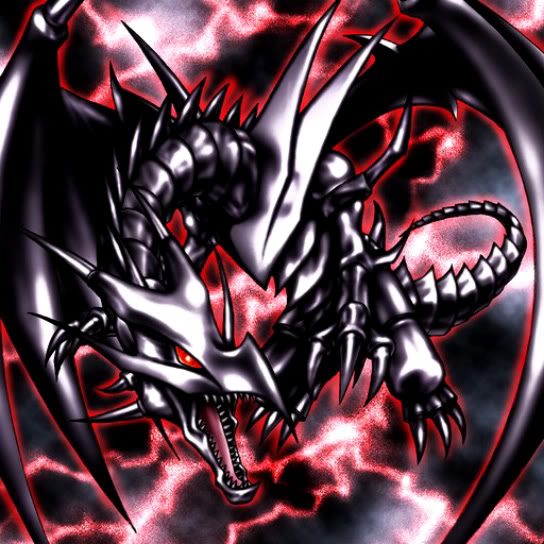
Looking Forward:
To those who have kept up with my Strategy Articles, thanks for your continued support. The subject for this article was chosen by a combined request of both readers and Org Staff, and I figured that I could throw some really neat deck ideas into the field for people to run with. In addition, I have a bit of an update to make – the number of CDS articles is going to considerably drop off following the next 2 weeks, as I will be studying abroad for a semester and will be unable to continue writing articles until my return to the interwebs. Just so you’re aware, I am hoping to get at least 1 more CDS article published before then, so be on the lookout for that!
